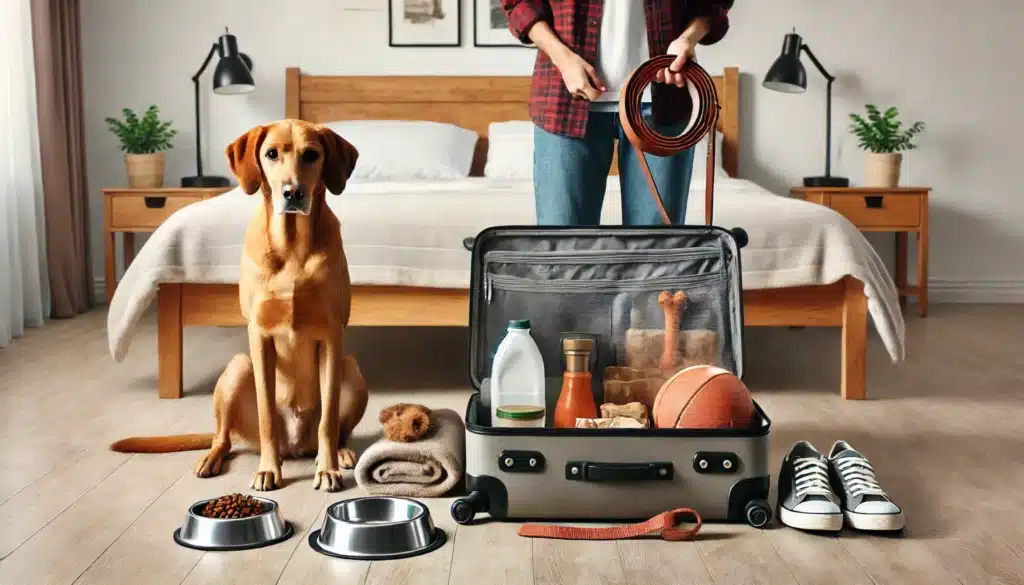A long journey can be exciting for you — and a bit overwhelming for your dog. Whether it’s a cross-country road trip, a multi-hour flight, or relocating to a new city, long-distance travel takes preparation to make sure your dog is comfortable, safe, and stress-free.
In this guide, you’ll learn how to get your dog ready for an extended trip, from building up travel tolerance to creating a routine that keeps them calm and happy along the way.
Step 1: Schedule a Pre-Trip Vet Visit
Before any long trip, check that your dog is healthy and travel-ready.
What to cover:
- Make sure vaccines and flea/tick preventatives are up to date
- Ask about motion sickness or anxiety treatments
- Discuss sedation options (only if absolutely necessary and with vet supervision)
- Request copies of your dog’s medical records
- Microchip check and ID tag confirmation
A quick vet visit gives you peace of mind and ensures your dog is physically fit for the road.
Step 2: Train for Longer Travel Sessions
If your dog isn’t used to being in the car or crate for extended periods, practice ahead of time.
For car travel:
- Take short drives, slowly increasing duration
- Reward calm behavior with praise and treats
- Try feeding meals in the car (parked) to create positive associations
For crate training:
- Leave the crate open at home and place toys or treats inside
- Practice “crate and wait” sessions with the door closed
- Gradually increase time spent inside, keeping it stress-free
Preparation builds confidence and predictability, especially for nervous dogs.
Step 3: Pack for Comfort and Routine
Dogs thrive on routine. Keeping some things familiar can make a long trip much easier.
Pack these essentials:
- Food and treats
- Collapsible water bowl + bottled water
- Leash and backup leash
- Favorite toy or chew
- Blanket or dog bed with a familiar scent
- Crate or carrier (if used)
- Poop bags and cleaning supplies
- Medications and health records
- ID tag and recent photo
Bonus: Stick to your dog’s regular feeding and potty times as closely as possible.
Step 4: Condition for Noise and Movement
Long trips often mean unusual sounds and motion — your dog needs time to adjust.
Desensitization ideas:
- Play car or airplane sounds at low volume at home
- Practice staying calm during engine starts, luggage packing, etc.
- Use calming aids like pheromone sprays, music for dogs, or anxiety wraps
For motion-sensitive dogs, anti-nausea meds or natural remedies can help — always check with your vet first.
Step 5: Plan Strategic Rest Stops
Dogs need regular breaks during travel — especially on long car trips.
- Stop every 2–3 hours for potty breaks and water
- Find dog-friendly rest areas or parks
- Allow time for sniffing and stretching, not just “quick potty stops”
- Keep your dog leashed at all times in unfamiliar environments
Pro tip: Research pet-friendly stops or pet relief areas along your route before you go.
Step 6: Practice Calm Exits and Entrances
Getting in and out of the car or crate should be calm, safe, and structured.
- Use cues like “Wait” or “Easy”
- Reward calm behavior before exiting
- Never open the door without your dog leashed or secured
- Reinforce polite loading/unloading at each stop
Consistency here prevents overexcitement and keeps your dog safe on busy roads.
Step 7: Prepare for Overnight Stays
If your trip includes hotels or rentals, be sure they’re dog-friendly and prepared for a canine guest.
Tips:
- Request a ground floor room, if possible
- Bring a crate for sleeping or when you leave the room
- Use a white noise machine or calming music to ease anxiety
- Don’t leave your dog alone unless they’re comfortable and quiet
- Respect hotel policies and clean up after your dog
Leave no trace — be the kind of guest that keeps hotels open to pets.
Step 8: Watch for Signs of Stress
During travel, observe your dog closely. Look for signs of discomfort:
- Panting or drooling
- Excessive whining or barking
- Refusal to eat or drink
- Trembling or cowering
- Pacing or trying to escape
If needed, take an extended break or change plans to prioritize your dog’s wellbeing. A safe, calm dog = a better trip for everyone.
Step 9: Have a Backup Plan
Be ready for changes, delays, or emergencies.
- Keep a list of nearby vets or emergency clinics along your route
- Carry extra food, water, and a towel in case of spills or accidents
- Have a backup leash and collar
- Use GPS tags or smart collars if your dog is prone to bolting
Planning ahead prevents small issues from turning into big problems.
Final Thoughts: Preparation Makes All the Difference
Long trips with your dog don’t have to be stressful — they can be a joyful, bonding experience when approached with patience, planning, and empathy.
Whether you’re headed on vacation or relocating, your dog looks to you for safety and comfort. Prepare them gradually, keep their routine in mind, and stay calm through the chaos. You’ll both arrive not just at your destination — but as a stronger team.
Because when you travel with your dog, the journey becomes part of the adventure.







